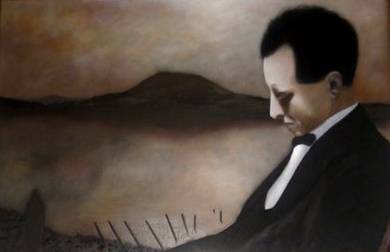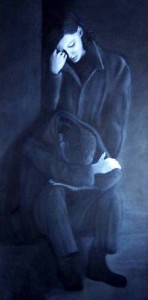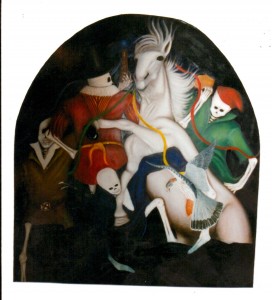Roy Guy: His Own Words
A small selection of Roy Guy’s paintings with written accompaniments, offering a deeper insight to both the images and the artist. Click final image for a short interview and unveiling of recent painting.
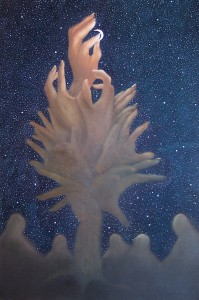 Catch the Moon
Catch the Moon
(Oils on canvas, measuring around 3ft x 2ft)
When my wife and I first met I said I’d give her the moon: in this painting I’m fulfilling that promise. The hands that form the majority of the tree belong to our children, the trunk is my arm and the hand catching the moon belongs to my wife.
The five figures around the base of the tree are our primitive ancestors; they are our soil from which we’ve grown. It is a genetic symbol — if all our DNA was put together it could possibly stretch as far as the moon.
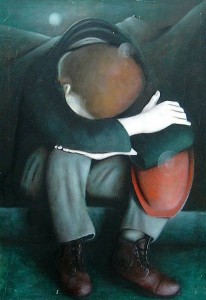 Seeds of Time
Seeds of Time
This painting came out of a poem I had published a long time ago called The Seeds of Time, but it was the title that gave me the inspiration not the actual words. Its an interpretation of the state of the Welsh — its culture and its language as I see it.
Although the man in the foreground is a miner who has just lost his job, he could be me or anyone else who feels the same way. He has a red helmet ( The Red Dragon of Wales) on his knee — look closely and you can see it cracking like an egg under the strain; he’s worrying about the future of himself and his family.
Floating through the painting are three Dandelion Heads, we used to use them as clocks and blow the seeds away: “One-o-clock, Two-o-clock, Three-o-clock.” Inside the heads are the faces of my three youngest daughters: they are my Seeds of Time — they are the future I worry about…as they scatter around Wales will they land on fertile ground? The mountain in the background is the past — slag tips created out of colliery waste shaped into the form of a female. It is Mother Nature dragged out of a hole in the ground, or as the writer Alexander Cordell saw it in his book a ‘Rape of a Fair Country.’
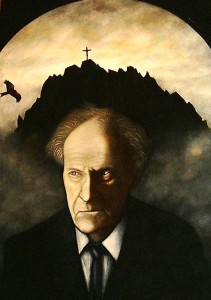 “What Immortal Hand or Eye could Frame Thy Fearful Symmetry.”
“What Immortal Hand or Eye could Frame Thy Fearful Symmetry.”
(The title is in Welsh on the painting.)
This oil painting on canvas measuring about 6ft 6inches x 4ft 10inches is now hanging at the Welsh Language Centre in Denbigh and came about after three months of research into the Welsh poet’s life and works.
R. S. Thomas was a complicated individual, a reverend of the Anglican Church in Wales. However, although Welsh through and through, he was brought up speaking English (“Poison,” he called it.) That’s the reason for the title of the painting being in Welsh — it is in honour of his dedication to his Mother Tongue, because I believe he would have preferred it that way.
The title itself is a direct quote from William Blake’s The Tiger, a poet/ artist whom R. S. Thomas greatly admired. This quote sums up the the entire painting. Thomas was, by all accounts, an awkward individual. Some who had first hand knowledge of his personality may have said he was fearful, but if you read into his works you may see another side creeping in, his doubt, and this is what this picture is all about.
In the foreground the poet looks sideways — he looks angry, fearful, but being fearful and looking fearful is two different things. Behind him are the shattered pinnacles of Castell y Gwynt (Castle of the Winds) on Glyder Fawr, Snowdonia, a place which I’m sure he would have come across on his many birdwatching travels. On top of Castell y Gwynt the cross of Jesus reaches into the sky, while the rocks it stands upon form the profile of a mans face. This man is so special to the poet R. S. Thomas: he is the peasant Iago Prytherch, a man who “Endures like a tree.” Look for him — you’ll find him in many of his poems. The poet in the painting is fearful — fearful because he doubted himself and his beliefs. Were the peasants he preached to in his church akin to Iago, were they closer to God than himself because they worked the land so religiously, scraping a pittance until they died, so immersed in the soil that they seemed part of it, part of creation itself?
The bird in the painting is a Red Kite — up until recently the only place you would find one was North Wales. R. S. Thomas was an avid bird-watcher who helped to set up bird sanctuaries across Wales. Maybe he was one of the reasons the Red Kite survived (Who knows?) The reason for including the bird in this painting is twofold. Firstly, it is comparable to the fate of the Welsh Language — with the help of certain dedicated individuals the Kite began to flourish again: will the language do the same?
But the main reason it has been included is because it is a tribute to one of our greatest ever poets, R. S. Thomas.
Just an ordinary man of the bald Welsh hills,
Who pens a few sheep in a gap of cloud.
Docking mangels, chipping the green skin
From the yellow bones with a half-witted grin
Of satisfaction, or churning the crude earth
To a stiff sea of clods that glint in the wind—
So are his days spent, his spittled mirth
Rarer than the sun that cracks the cheeks
Of the gaunt sky perhaps once in a week.
And then at night see him fixed in his chair
Motionless, except when he leans to gob in the fire.
There is something frightening in the vacancy of his mind.
His clothes, sour with years of sweat
And animal contact, shock the refined,
But affected, sense with their stark naturalness.
Yet this is your prototype, who, season by season
Against siege of rain and the wind’s attrition,
Preserves his stock, an impregnable fortress
Not to be stormed, even in death’s confusion.
Remember him, then, for he, too, is a winner of wars,
Enduring like a tree under the curious stars.
Cofiwch Tryweryn (Remember Tryweryn) & Saunders Lewis
This oil painting on canvas measuring 3ftx 2ft is on permanent display at the ‘Tym- y- Nant Theatre’ in Denbigh, North Wales.
This picture portrays two Welsh icons: Saunders Lewis and Llyn Celyn.
Saunders Lewis ( 15 October 1893 – 1 September 1985) was a Welsh poet, dramatist, historian,and literary critic. Also a political activist, he was a founder of the Welsh National Party which later became known as Plaid Cymru. Lewis is usually acknowledged to have been among the most prominent figures of twentieth-century Welsh-language literature. He was a 1970 Nobel nominee for literature, and in 2005 was voted 10th as Wales’ ‘greatest-ever person’ in a BBC Wales poll.
Capel Celyn was a rural community ithe Afon Tryweryn valley in North Wales. The village and other parts of the valley were flooded to create the reservoir in the painting called Llyn Celyn (otherwise known as Tryweryn Reservoir) in order to supply Liverpool and The Wirral with water for industry.
At that time Capel Celyn was one of the last Welsh-only speaking communities, so its flooding created a lot of controversy. When the valley was flooded in 1965, the village and its buildings, including the post office, the school, and a chapel with cemetery, were all lost. Twelve houses and farms were drowned, and 48 people of the 67 who lived in the valley lost their homes — in total some 800 acres were submerged by the waters of Llyn Celyn.
Saunders Lewis was born Wallasey Liverpool, the same city behind the demise of Capel Celyn (In 2005 Liverpool formerly apologised for the flooding.) When I came across the tale of Capel Celyn it seemed to fit in with what I wanted to portray.
Saunders Lewis co-founded the National Party of Wales in 1925 and Capel Celyn was flooded in 1965, but although there’s a different time frame they both affect each other because the flooding caused so much controversy that it pushed up the membership of Plaid Cymru, which would have had a significant role in the creation of the Welsh Assembly, the major political aim of Lewis. Lewis is usually acknowledged to have been among the most prominent figures of twentieth-century Welsh-language literature — in this painting Capel Celyn has become a stage, its drama unfolding like one of his plays. On the bottom left of the painting stands a solitary figure — he is a Quaker from the seventeenth century, one of many who used to worship in Capel Celyn at a farmstead called HAFOD FADOG. He is lamenting the loss of the village and his fellow Quakers buried just behind the wall. So Cofiwch Dryweryn and Saunders Lewis because although they are part of our history, they have helped form our future.
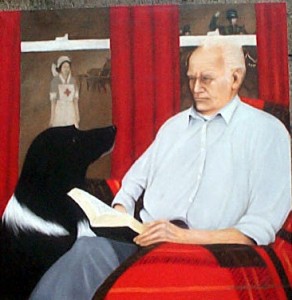 Joe & Sam
Joe & Sam
(Oils on canvas measuring about 3ft x 2ft)
This painting is in Joe’s house, being looked after by his wife Gwen.
Joe died a few years ago — he was a very good friend of mine and he loved his dog Sam. Joe was a ‘Desert Rat,’ a sergeant in the Second World War. In the window is a reflection of his past, where he’s on horseback dragging a cannon through the desert. His wife Gwen, an army nurse, is also there in her uniform. Joe was a religious individual: in his hands he holds the Bible, and looking on is his faithful dog Sam.
Closing Cwm
Closing Cwm is an oil painting on a hessian screen I found in a skip, it measures 2ft 4inches by 5ft 6inches.
The title really says it all — the man has just been made redundant from the Cwm Collery near Ebbw Vale, which is the top end of the Western Valleys in Wales. He is distraught: his wife is above him, arm resting on a wall, her sadness empathising his distress.
I find this painting could be a reflection of anyone, of any country, so in reality it should be shown without an explanation — let the spectators make up their own minds.
“The Row of Terraced Houses Hung Like a Necklace Round The Black Tart’s Neck”
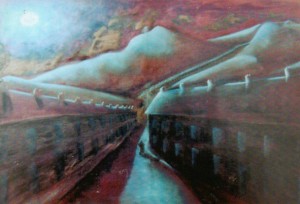
(Oils on Calico, measuring around 2ft x 18inches)
A book dealer came to me and asked me to do a painting based on a quote he’d found: “The Row of Terraced Houses Hung Like a Necklace Round The Black Tart’s Neck.”
The ‘Black Tart’ I saw as a mountain of coal waste (similar to the one behind our house when I was growing up), hence the female form in the background. The terraced houses that that you can see coming from her neck to the village in the foreground are similar to the street my Nana used to live in. The book dealer was an avid Dylan Thomas fan, so I’ve put the Welsh poet underneath the light at the end of the street walking towards us. When I gave him the painting he said: “That’s just how I saw it.” This is the only painting of mine that I’ve sold, not for money, but for some books I needed for my Degree, and I’ve always regretted it. (It’s a long story.)
The Mari Lwyd
This very large oil painting on canvas has been hanging in Newport Central Library for over ten years and measures about 8ft x 6ft.
I became interested in history of the Mari Lwyd when reading Robert Grave’s book ‘The White Goddess’ and began researching into its background. Then when I read ‘The Ballad of the Mari Lwyd’ by the Welsh poet Vernon Watkins it inspired me to take it further. Slowly but surely an image started to form in my mind, not of the skeleton remains of a horse’s head being put onto a pole and taken from door to door by living people, but the opposite — of a fearful living ‘Nightmare’ with a retinue of human skeletons, attending pirates from Davey’s locker.
The original Mari Lwyd came out of the sea or the entrance of a castle — in this picture it is emerging from the latter. This fearful mare doesn’t take your food, it is only interested in your soul — the bag on the right being carried by one of the skeletons is used to carry them.
The red coated skeleton just behind the mare seems to be the leader of the buccaneers and is holding a metronome made from the wood of the Taranis Wheel. It is engraved with runic writing that means ’The Horse of Frost’ (taken from the prologue of Vernon Watkins’s Ballad of the Mari Lwyd.) From the top of the metronome flutter some coloured ribbons, as if dancing to its tune (Morris dancing). It is used as a rhythmic timing device for when they catch their victims — if you can’t come up with a rhythm to complement the one they’ve been given then they take you and your soul back with them to Hell.
Hovering in front of them is a Merlin Hawk (symbolising the magician). He is on this side of the small wall that one of the skeletons has just started over. He represents the good: can he use his magic to stop their advance; will he succeed?
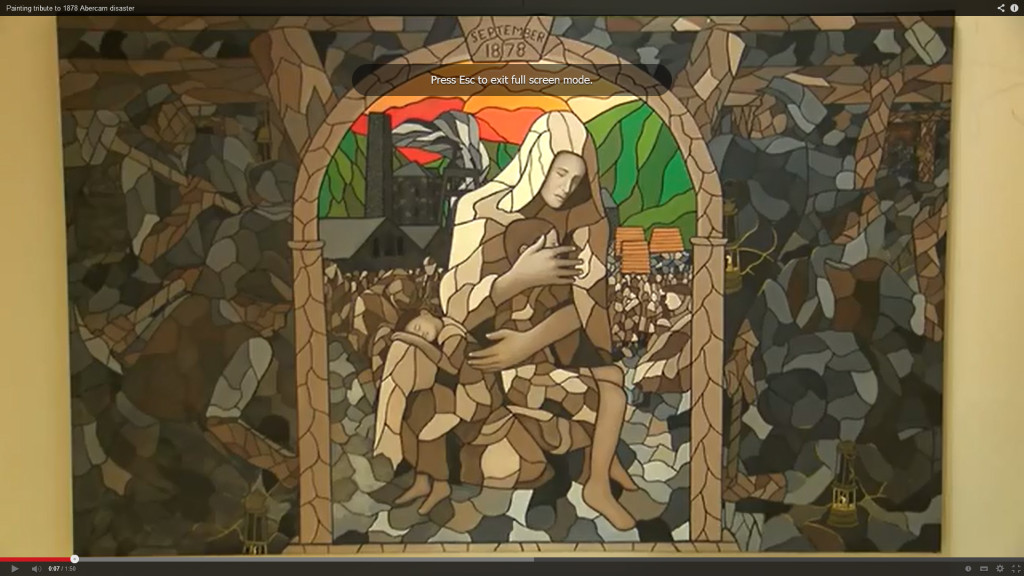
Click on the image to watch a youtube video of the unveiling of this painting, and short interview with Roy Guy.
Painting to commemorate 1878 Abercarn disaster, by Roy Guy
Your chance to own ‘Going for the Line’

Going for the Line
WINDOW ONTO WALES…WINDOW ONTO WALES…WINDOW ONTO WALES
Hosted by Wendrich artHouse

